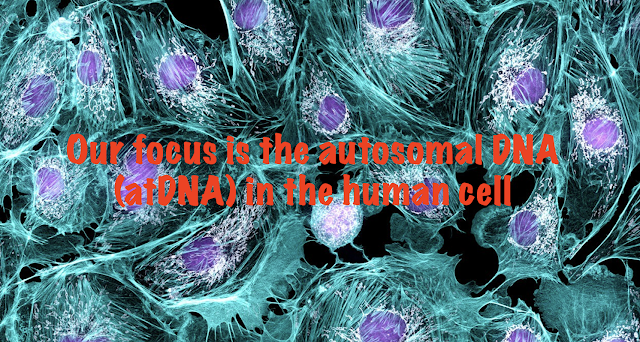MODULE 1: Introduction - "4 types of DNA, 3 types of DNA tests"
These notes are for participants in the Society of Australian Genealogists' program Analysing your AncestryDNA results. Others are welcome to use these notes for their personal research. Please contact me at chrisw9953[at]gmail[dot]com for other uses. I'll strive to update the notes as there are further developments or my understanding of the area grows.
In July 2021, Ruth Graham convened a panel for "Let's talk about...DNA". In July 2022, Ruth convener a panel for "Let's talk about Investigative Genetic Genealogy". You can access the recordings though the Members area HERE. These are general and most interesting discussion.
My three favourite sites for genetic genealogy are-
4 types of DNA
- autosomal DNA (atDNA) in 22 pairs of chromosomes (1 to 22) with one side from Dad and the other side from Mum and
- chromosome 23 is the sex chromosome - males get Dad's Y and Mum's X, females her Dad's X and Mum's X.
Mitochondrial DNA (mtDNA) is around the nucleus. This is passed down from mother to child.
3 types of DNA tests
All the leading testing companies test atDNA. These are often called "cousinship tests". FamilyTreeDNA is the only company that tests the four types of DNA. The focus of our program is atDNA tests at AncestryDNA.
You can find information about DNA test prices, sales and discounts HERE.
DNA inheritance paths
 |
| https://dna-explained.com/2021/01/04/genetic-genealogy-at-20-years-where-have-we-been-where-are-we-going-and-whats-important/ |
- Y-DNA is passed down from father to son on the patrilineal line,
- mtDNA is passed down from mother to children on the matrilineal line and
- atDNA is inherited 50% from Dad and 50% from Mum and back through the generations but the further back the less likely you are to inherit atDNA.
 |
| https://genie1.au/x-dnas-helpful-inheritance-patterns/ |
Males and females have a different X-DNA inheritance pattern. Males only inherit X-DNA from their Mums. Females inherit X-DNA from Dad and Mum.
Some reading-
You can watch Andrew Redfern's talk on using Y-DNA to follow his Redfern line HERE.
atDNA inherited and shared
 |
| https://isogg.org/wiki/Autosomal_DNA_statistics |
For each chromosome (1 to 22), we inherit one side of the pair from Dad and one side from Mum which contains a random mix of DNA from their Dad and Mum (your grandparents). This is called recombination. Remember each child will get a different mix of their grandparents's atDNA.
 |
| http://smithplanet.com/stuff/gedmatch.htm |
Remember that not all of your ancestors atDNA gets to you. The further back you go, the less likely it is that your ancestors' atDNA will be passed down to you. The "porcupine chart" shows that your genealogical tree and your genetic tree are different. Through traditional genealogical research, you may have the names of your fourth great-grandparents but none of their atDNA may have been passed down to you.
The focus of our program is atDNA testing at AncestryDNA where they report that-
- 100% of the time you share atDNA with second cousins or closer and inherit atDNA from great-grandparents.
- 98% of the time you share atDNA with third cousins or close and inherit atDNA from second great-grandparents.
 |
| https://gcbias.org/2013/11/11/how-does-your-number-of-genetic-ancestors-grow-back-over-time/ |
When you're researching your matches at the various testing companies, bear in mind the likelihood they will report as a match. This excellent chart prepared by Louise Coakley will assist you. Also, remember that at AncestryDNA the match may be below 20cM and more difficult to locate.
 |
| https://genie1.au/atdna-finding-matches-on-all-ancestral-lines/ |
DNA testing strategy for Australians
You can read my current thoughts HERE.
Leah Larkin provides very useful information on the numbers of atDNA test by companies. Many people take 23andMe test for their health reports.
 |
| https://thednageek.com/dna-tests/ |
Genetic genealogy for the family historian
It's important to understand what genetic genealogy can/cannot do for our family history research. You should also think about your DNA dilemma/s and have a plan for addressing the dilemma/s.Our program will be working on the left hand side of this diagram. Each module will focus on one area - grouping matches, finding most recent common ancestors with matches and tracking the matches. The process is iterative. Once you have a strong foundation in the left hand side, you can move to the right hand side which is covered in Veronica Williams' program Analysing your DNA results with chromosome analysis.
Transferring AncestryDNA data to other sites
Once you have mastered working at AncestryDNA, you should consider transferring your atDNA to other sites to see if you find more matches. This is often referred to as "fishing in all the ponds". Louise Coakley has excellent instructions HERE.
One last thought
We all come to the program with different levels of understanding, different DNA dilemmas to work on and different DNA matches to work with. Please keep in touch with me and the group during the program.








